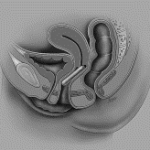 What`s a Pessary?
What`s a Pessary?
Vaginal pessaries are an established non-surgical treatment option for women with pelvic organ prolapse and stress urinary incontinence and are used routinely in many clinics and hospitals.
A pessary is a silicone device that sits in your vagina to help support the vaginal walls, bladder neck, pelvic organs (bladder, uterus and rectum) and its surrounding connective tissue
Pregnancy, childbirth, a persistent cough and constipation all produce downward pressure on the pelvic organs, thus stretching the connective tissue that helps to support our bladder/uterus/rectum from above. A pessary can help to support the organs and its strained surrounding tissues, thus alleviating the symptoms of prolapse (heaviness, difficulty emptying bladder and bowel, leaking during exercise).
It can also be used as a short-term support solution whilst you are building up the pelvic floor sling and recovering from pregnancy, to allow you to lift or exercise safely without any symptoms.
How does fitting work?
It is ideal for you to have a full 60min appointment with your pelvic health Physiotherapist first to establish a full background on your history, current symptoms and goals. An internal pelvic exam will be also carried out during that to ascertain if a pessary is the best treatment option for you.
The follow-up pessary fitting can then be done in 45min. This involves trying different shapes and sizes to see what works best with your anatomy and symptoms. The most suitable pessary will be yours to keep and use at home.

How do I use my pessary?
The Physiotherapist will show you how to insert and remove the pessary yourself during the pessary fitting. How often and when you wear it depends on you and what your Physiotherapist advises. You may just wear it for physical activity.
It is always good if you can try to empty your bladder before you leave the clinic. You will receive a follow up email or call that day to ensure you are happy with the fitting and that there are no issues to report
After the fitting you will need to return to clinic to have the pessary and vaginal tissues checked 2-3 weeks later.
After that a 30min follow up check every 3 months whilst you are using your pessary is good practice. Signs and symptoms can change and improve over the course of time and you may need a smaller size for it to be effective.
Does the pessary have any side-effects?
Most of the potential side effects of the pessary are very low risk. However, its important you are aware of them and can remove the pessary if required.
You may notice more vaginal discharge than normal, as the vagina gets used to the pessary, that’s ok. If you have bad vaginal odour, lots of discharge, pain or bleeding (not associated with a period), you should remove the pessary and contact your pelvic physiotherapist or health care provider.

Can a pessary get lost or fall out?
The vagina is a closed tube at the top so there is nowhere for the pessary to get lost inside the vagina. The pessary may fall out of the vagina, just pop it back in. If the pessary continues to fall out, let your Physiotherapist know as it may be too small and need to be re-sized.
What else should I know?
Be sure to tell your Physiotherapist straight away if you experience any discomfort with the pessary or any trouble urinating or having a bowel motion.
A letter will be written to your GP or consultant informing them of your pessary fitting and ongoing management plan. If you so not wish for this communication to happen, please inform your physiotherapist
Initial pelvic health check 60mins £120
Pessary Fitting 45min £140
Follow up 30min pessary and pelvic health check £60
